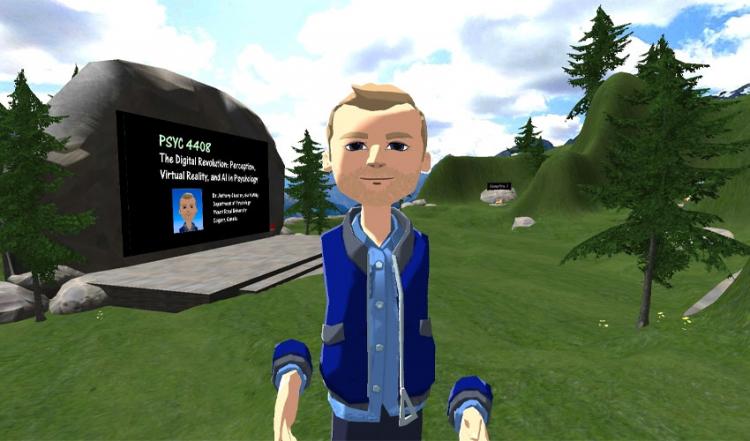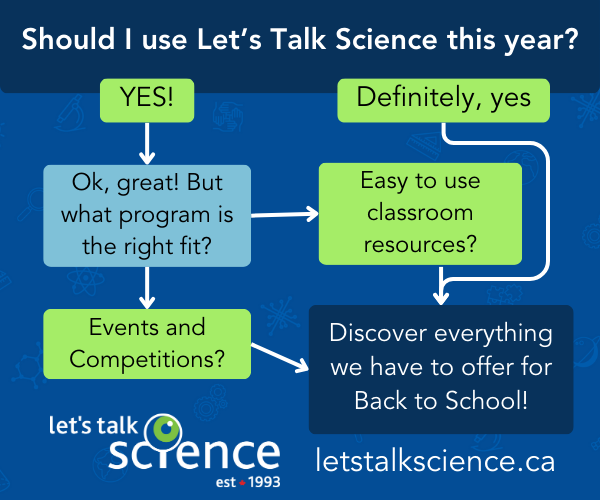We're shifting back to in-person learning after a year of online schooling, but a new course at MRU is taking students where no class has gone before - into virtual reality (VR).

Anthony Chaston in worlds he created for his virtual reality psychology course.
The Digital Frontier: Perception, AI and Virtual Reality in Psychology is both about, and takes place in, VR. Students access the course through headsets and inhabit worlds created by Dr. Tony Chaston, PhD, a professor in the Department of Psychology.
The first of its kind in Canada, the class, which started Sept. 14, filled its 20 spots (standard for a fourth-year psych course) in a matter of days. It started with a discussion of artificial intelligence (AI) and parallels to human perception. Much of the architecture used to make artificial neural networks was originally designed on the structure of neurons, or parallel distribution processes.
"I want to get into that, but not just about what AI is, because I don't want to talk about it from a computer science point of view," Chaston says. "This is a psychology course, so a lot of it is going to be about our interface with AI. Most people don't even know that they use AI all day every day. Google, Facebook or any social media, it all involves AI."
Chaston's background is in human visual perception: how the eyes take in light and how we perceive scenes and make sense out of them; then how we use that knowledge to get somewhere. He's combined this with an interest in the outdoors, wilderness and navigation during hiking.
"It progressed to VR mostly because I was looking for other ways to simulate outdoor experiences in the lab and VR obviously jumped out when that started to happen."
That physical nature and more importantly the experience of VR - being present and fully immersed - is another pillar of the course that blends with social interaction in a virtual space.
"Immersion in media is a topic that's been around for a long time, but it takes on a whole different level when you talk about it in VR," Chaston says, noting it will play a role in everything from work and play to shopping as retailers set up VR stores.
After diving deep into what VR is and how it works, the course will focus on Chaston's research into using VR nature scenes to lower stress levels. The class is set up as a three-hour block and already students have been invited to a couple of VR "events" to ensure they are comfortable in the space.The first day was an introduction, including basic etiquette for behaviour in VR. While most class time will be in VR, there will be time for group work that uses other more traditional online formats like Google Meet so that students aren't wearing headsets for three hours straight. As note-taking is tough in VR, those will be provided separately.
How an idea became reality
Chaston credits Anna Nuhn (who has since left MRU) and Erik Christiansen at the Riddell Library and Learning Centre and MRU psychology professor Dr. Evelyn Field, PhD, for their help over the past year in developing the course.
"This course is possible thanks to Tony's willingness to immerse himself in the pedagogy of VR and best practices for designing virtual learning environments," said Christiansen, an assistant professor and subject librarian at the MRU Library who has a background in information technology.
"VR technology is more affordable today, so it will be within reach of more students every year. Exposing students to VR early will get them comfortable with the technology, which will likely be utilized in more industries moving forward. Tony's efforts demonstrate educators' willingness to experiment with new technology, and I believe students will benefit enormously from his work."
VR is a natural progression from traditional online learning, Christiansen observes, but provides a much more social experience, noting that he, Chaston and their colleagues met over the summer in VR. Physical trips and fieldwork will remain important aspects of higher education, but VR can put students in environments that could be too risky or impossible otherwise.
"Thanks to photogrammetry, we have the ability to render real-world environments as high-definition 3D worlds. Students can take virtual field trips to dangerous mountain peaks, volcanoes, fragile archeological sites, or Mars. Creating these environments takes some work, but it is less laborious today; in the future, educators will have access to better creation tools and pre-built experiences for students. VR has the potential to take learning to new heights - in ways that face-to-face and traditional online education couldn't."
Ash Dembicki is a fifth-year psychology student working on her honours thesis in virtual reality nature therapy. She has some experience in VR, having attended meetings and practised meditation in the virtual space, and was drawn to the course first and foremost by Chaston's passion for his subject matter and "contagious energy as a teacher and researcher."
"The fact that he has creatively and bravely decided to teach a university course fully in VR is astounding," she says. "I also am drawn to VR as I believe it is an accessible tool that will be able to help many more people around the globe. What the field of psychology is doing in VR is just the beginning - it can especially help with mindfulness and presence, as well has many benefits for treating PTSD and systematic desensitization therapy."
Dembecki says she's hoping to learn about the use of VR in therapy and counselling.
"I plan on working in trauma-based counselling, and using VR as one of the tools to help suffering individuals heal and move on to a healthy state."
The VR foundation
Chaston built the course in AltSpaceVR, a large VR platform that allows for maximum flexibility and the use of a large range of headsets. Last summer, he learned Unity (a "game engine" used to design video games) to allow for more scope to these worlds, having gained experience building spaces in VR through his work with VR research and teaching groups.
"We're not just teaching a new course. We're teaching a new course on a new platform and we realized quite early on that the implications for that go beyond just my course. It sets a precedent for how this will be done at the University. We didn't want to just rush into it."
All the classes' learning spaces are built on a Rocky Mountain theme, with a panoramic 360-degree view of the mountains as a background - think VR but with an element of augmented reality. So why not just take students outside, or even on a trip to the mountains? Chaston suggests that the idyllic vision of taking a class outdoors to a grassy common isn't actually very realistic.
"I tried that in real life. It's not very practical. The grass is wet, the students have all these books and computers and stuff with them. It's hard for them to get up and move somewhere. There's nowhere for them to plug in. It doesn't actually work. In VR? It works great."













